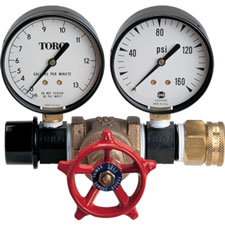Welcome
to our Do it Yourself Seminar
There is a lot of work to putting a system in, but if you are
an avid do-it-yourselfer you may have the skills to put a system
in yourself. The most important part is getting the particulars
right. Such as gallons per minute available from your water
source, be it a pump or city water supply. Size of the lawn
as a whole, and divided up into sections.
This will give us the information needed to determine the number
and type of sprinkler heads required to water each area. Matched
precipitation is important also, this will put the same amount
of water on all parts of the lawn so you don't have dry spots
and wet spots.
If you are serious about tackling this project, but are unsure
of where to start, we can (when given the required information)
design a system for you and provide instructions on how to do
each step of the installation process. If this interests you
Contact us @
In
this Seminar, you will learn:
- Rotor
Heads Versus Spray Heads
- Head
to Head Spacing Including:Square
Spacing, Special-Pattern Spacing, Odd-Shaped Areas
- Timers
& Timer Location
- Valve
Assembly
- Drip
Products
- Zones
- Layout
The Pipe
- Trenching
By Hand Vs. Trenching With A Trencher
- How
To Flush The System To Clear Debris
- Check
Your System Operation, Zone-by-Zone
 Before
The Seminar, You Will Need To Do Some Measuring: Before
The Seminar, You Will Need To Do Some Measuring:
- Using your
tape measure, outline and measure your property accurately according
to scale, laying out the locations of your home, sidewalks,
grass, etc.
Measuring Your Yard - The first step
to designing your sprinkler system is to measure your property.
- Step
1. Measure the distance around the outer edge of your lawn
otherwise known as the property line. Draw the measurements
on graph
paper as you measure./li>
- Step
2. Measure the distance around the house and any landscaping
you might have around the house, and add the measurements
on the graph paper.
- Step
3. You will need to figure out where the house sits on the
lot, and that can be done by the following, Measure from the
front right corner of the house to right side property line
and mark that on the paper, Then measure from the front right
corner of the house to the street and mark that on the graph
paper.
- Hunter
Industries /a>
CONSIDER
THESE WHEN DRAWING YOUR PROPERTY:
- Outline
your house, garage and other structures.
- Show
walks, drives, slabs, patios and surfaces.
- Locate
and identify trees and major obstacles.
- From
the outside of your house, measure outward to define your
perimeters.
- Identify
any slopes on your property.
- Locate
ground cover, grass, flower beds and landscaping.
- Identify
the size and location of the water meter (or pump) and main
line.
- Re-check
your measurements at several different points.
- Make
sure your drawing accurately indicates the true dimensions.
- Flow
& Pressure Gauge. If you do not own a flow &
pressure gauge, ask your local rental center. We have these
available as well. Gather
 Required Information. Required Information.
- Water
pressure can vary from home to home, even on the same street.
So it's important that you take a measurement at your own
home. If you push your system beyond its capacity, the danger
is that it can create water hammer and costly damage to
your piping system. Also, if you exceed the pressure or
water flow (GPM) you have available, your system will not
function or work efficiently. We recommend using the flow
and pressure gauge method because it's fast and easy.
- DETERMINE
THE DIAMETER OF THE WATER SUPPLY LINE Call your local
water company or measure your supply line (the pipe leading
from the water meter to your house).
- A
certificate of survey of your property, which is available
from the city if you don't have one, Otherwise you will need
to measure your yard following the simple steps below.
- Call your
local water company or the proper municipal authority for information
on building codes or permits required for the installation of
underground sprinkler systems.
|
Warning
Personal injury may result from trenching
over buried power lines or gas lines. Before digging or trenching,
check with your local utility companies to identify any buried
cables, pipe or gas lines.
Time
to Fill Bucket |
Gallons
Per Minute |
15
Seconds |
20
GPM |
20
Seconds |
15
GPM |
25
Seconds |
12
GPM |
30
Seconds |
10
GPM |
40
Seconds |
7.5
GPM |
This
is how much water is available with a working pressure of
40 PSI or the higher reading that you recorded. (Minimum operating
pressure for most sprinklers is 35 PSI.)
If
you use a different size bucket, time how long it takes to
fill it. Convert this to gallons per minute using the following
formula:
60
÷ Seconds x Gallons
For
example: A two-gallon bucket that fills in 15 seconds means
the available flow is 8 gallons per minute.
60
÷ 15 x 2 = 8 GPM (gallons per minute) |

